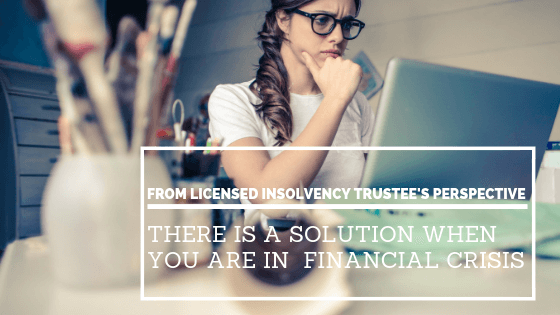Managing a business is never easy. Having some professional guidance along the way will definitely be a big help.
Many people are familiar with the statistic that over 50% of businesses will fail in their first three years. The reality is that for some businesses, they may fail due to various reasons like a cash flow crisis, lack of access to more credit and sometimes weak financial or operational management. So, when a business fails to make payment to satisfy a loan requirement and heads towards insolvency status, what professional advice is there to prevent, or even avoid such a situation? If the business owner is in financial difficulty, what about personal insolvency?
Today I am so glad to have Nicholas To to explain the details about the insolvency processes in Canada and his advice for business owners as well as individuals.
 Nicholas is a Licensed Insolvency Trustee with Hoyes, Michalos & Associates Inc., who works with clients in the Greater Toronto Area to help them eliminate their debt. He takes pride in providing personalized debt relief solutions to professionals, entrepreneurs, small business owners and individuals struggling with overwhelming debt. Although he grew up in Canada, Nicholas is fluent in Cantonese.
Nicholas is a Licensed Insolvency Trustee with Hoyes, Michalos & Associates Inc., who works with clients in the Greater Toronto Area to help them eliminate their debt. He takes pride in providing personalized debt relief solutions to professionals, entrepreneurs, small business owners and individuals struggling with overwhelming debt. Although he grew up in Canada, Nicholas is fluent in Cantonese.
Alex: Nicholas, thanks for your time. Let’s start first on the business side. I know you handled many insolvency cases. What are those major causes of business insolvency? Are those preventable?
Nicholas: The leading cause of insolvency among small business owners is using debt to address a cash flow crunch. Sometimes this is due to poor planning, not having enough capital or credit invested in the business to begin with. Sometimes it is caused by a downturn in revenues. Small business owners, and even those who are self-employed professionals, often choose to use personal credit cards, or defer payments to CRA to stay afloat. Unfortunately, unless they have a solid plan to turn things around, this can snowball into more debt than the business, or individual, can handle. The starting point is to cut back on expenses as much as possible and prioritize debt reduction.
Alex: I agree. So, from an insolvency professional’s perspective, how could you help them out? What are the procedures on a business insolvency case?
Nicholas: If a business is unable to cut enough expenses to become cash flow positive, and cannot obtain alternative, affordable credit to consolidate high cost credit card & catch up on CRA obligations, the next option to deal with the debt may be to file insolvency.
A business owner has two options to deal with their debts, including director’s liability: file bankruptcy or make a proposal to creditors.
In a bankruptcy, the debtor is required to relinquish non-exempt assets and make payments based on their income. One of the exemptions allows by provincial law is for what is called ‘tools of the trade’. In Ontario, tools and property used to earn a living up to the current limit of $11,300 are exempt from seizure. Being able to retain necessary equipment can help a small business owner continue to earn a living even after filing bankruptcy.
Another option is to file a proposal to creditor, effectively a deal to settle the outstanding debts for a percentage of the total amount owing. If the personal and business debts, excluding a mortgage, do not exceed $250,000 it is possible to file a consumer proposal. If unsecured debts exceed $250,000 then the small business and owner can file a Division 1 proposal, which has the same impact of eliminating debt, just a few different rules and procedures. A consumer proposal is streamlined to help individuals and very small businesses restructure their debts and recover.
In our practice we deal with individuals, which includes small business owners and self-employed professionals. Larger corporations have other options, and generally would turn to a larger, national firm to handle such a complex insolvency proceedings.
Alex: In insolvency practice, is it required a license to operate in this area? Any specific regulations? How does a designated insolvency professional help clients?
Nicholas: In order to provide insolvency services under the Bankruptcy & Insolvency Act, someone must be a Licensed Insolvency Trustee, or LIT for short. LITs are licensed and regulated by the federal government of Canada. The process to become an LIT is quite rigorous, requiring training and passing several examinations. In Canada, lawyers are not licensed to do insolvency proceedings. A bankruptcy lawyer can provide advice about how the law applies, but you must visit with a Licensed Insolvency Trustee in order to file a bankruptcy or proposal to creditors.
When someone meets with an LIT, we review their financial situation and help them develop a plan to deal with their debt. That includes discussing all options including debt consolidation, bankruptcy and a proposal. Our objective is to provide the information necessary to find the correct solution. If a bankruptcy or proposal is the way to go, the Licensed Insolvency Trustee will guide them through the process.
Alex: On personal insolvency cases, there are two solutions to relieve from insolvency: Proposal and Bankruptcy. What are the differences? What do you generally recommend to clients?
Nicholas: You are correct, for individuals the two most common approaches are to file personal bankruptcy or to make a consumer proposal. Which option that makes sense depends entirely on the individuals financial circumstances.
In a bankruptcy, in addition to giving up non-exempt assets, the bankrupt is required to make payments based on their income. The more you make, the more you pay. This is based on rules and regulations set by the federal government, not the trustee and are known as surplus income limits. If you earn over the limit, you must pay extra into your bankruptcy estate and you will be bankrupt for longer. This can prove costly on a month to month basis.
A consumer proposal is an alternative to bankruptcy. In a proposal the debtor can keep all their assets, and they make payments based on what can be negotiated with their creditors. Payments can be extended up to a 5 year period and are often much less than they would be in a bankruptcy if the individual has a high income or has assets with equity they wish to keep.
The correct answer can only be determined after attending a debt assessment meeting with a Licensed Insolvency Trustee.
Alex: Thanks Nicholas. I appreciate your time and input. One last question for you, why you chose to become a professional insolvency professional? What makes you so proud?
Nicholas: I enjoy helping people solve a financial crisis. Whether they file bankruptcy or a proposal is not the most important to me. It’s helping them find a plan that works for them.
Alex: Thank you again. Nicholas.

Recent Comments